Sky Brightness
The maximum acceptable sky brightness for an observation is defined as a single constraint expressed in terms of the number of magnitudes the r' band sky is brighter then best possible dark sky conditions. The sky brightness model used, courtesy of Ivan Baldry, was derived from several years of real LT RATCam data and incorporates solar elevation, lunar phase, lunar elevation, target elevation and distance of target from the Moon. For example, the same moderate sky brightness arises from a gibbous Moon low on the horizon or a crescent Moon high in the sky. (Many other examples showing the influence of Sun and Moon on the total sky brightness are shown in the pictograms below.)
The table below provides guidelines on how to convert traditional phenomenological criteria to the measured sky brightness classes used by the scheduler.
| Traditional brightness label | Sun altitude below horizon (deg) | Moon phase & distance | Measured sky brightness (mags) | Scheduler sky brightness class |
|
|---|---|---|---|---|---|
| Vr'i' | u'Bg' | ||||
| civil | <4 | N/A | <10 | <11.5 | 10mag |
| nautical | 8 - 12 | N/A | <6 | <7.5 | 6mag |
| astronomical | 12 - 16 | Bright or v.near | <4 | <5 | 4mag |
| astronomical | 12 - 16 | None or far | <2 | <4 | 2mag |
| dark | >16 | Gibbous & near | <2 | <4 | 2mag |
| dark | >16 | Gibbous & far | <1.5 | <2 | 1.5mag |
| dark | >16 | Crescent & near | <0.75 | <1 | 0.75mag |
| dark | >16 | None or v.far | <0.3 | <0.4 | dark |
Variation with wavelength or filter
As with seeing, the scheduling constraint is based on r' band irrespective of the filter or instrument you are using. Comparing to other filter passbands:
- Vr'i' are all very similar to each other
- u'Bg' are about one mangitude more strongly affected by twilight and moonlight
- z' band is about one magnitude less affected
Note again that the criterion is expressed relative to the best possible dark sky in that filter. We are not saying the absolute sky flux in Vr'i' are all the same, only that in astronomical twilight, each is about two magnitudes brighter than it would be in full dark.
Groups without a Sky Brightness Constraint
As with all Observing Constraints, a group with no sky brightness set is completely unconstrained. I.e., you are happy to observe from the moment the Sun is below the horizon; perfectly legal, but not likely what you want.
Availability of the different brightness classes
The precise amount of time available to observe any given target on any given night is dependent on both the target's and Moon's positions (RA, Dec). It varies through the month as the Moon waxes, wanes and indeed moves. For high declination fields the Moon may never come particularly close to your target. The following plots have been derived by averaging simulations of three years of observing conditions for targets at a range of declinations.
Scheduling is performed in terms of "observe whenever the sky is equal to or darker than the specified limit" and not "observe when the sky brightness is equal to the specified class" so cumulative plots are most important for deciding how likely your target is to be observed. Though not as relevant to the scheduler, plots of the differential distributions are also included below.
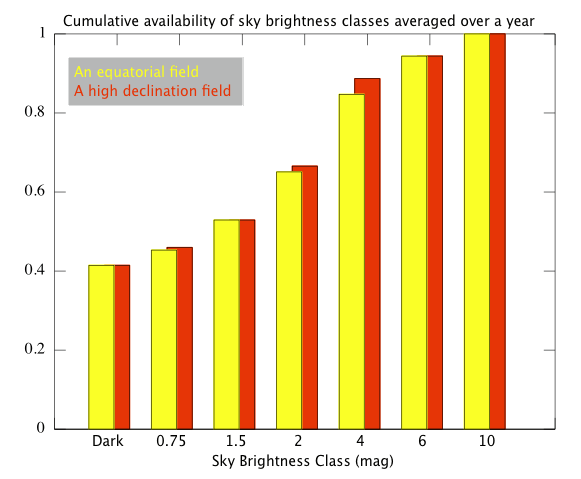
Total cumulative availabilty of observing conditions averaged over a long time
period. Roughly 40% of the time the sky is 'dark' whereas about 65% of the time
it is equal to or darker than '2mag' which is what would traditionally have been
described as 'astronomical twilight'.
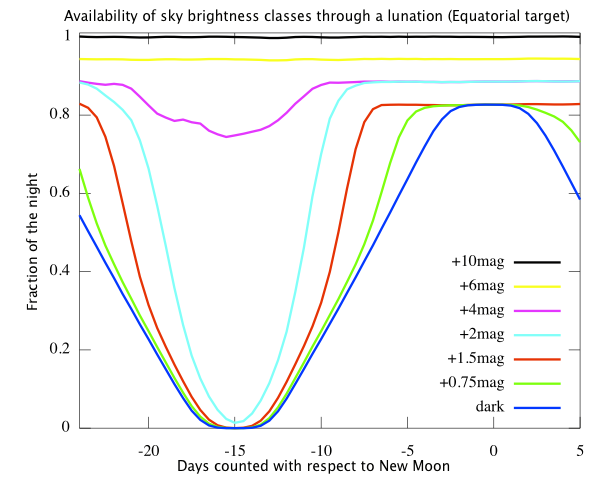
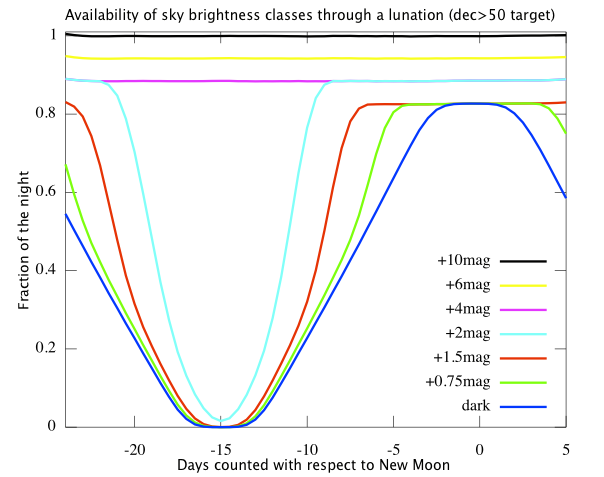
Plots illustrating how the availability of different conditions varies through
a lunation. For a particular source in a particular month this plot can vary
hugely. These plots represent an 'average month' derived from three years' worth
of simulations. The greatest difference between the two panels is that for a high
declination source, the Moon never gets close enough to push the sky into the
'+6mag' class so the magenta '+4mag' line is determined entirely by twilight, not
by Moon phase.
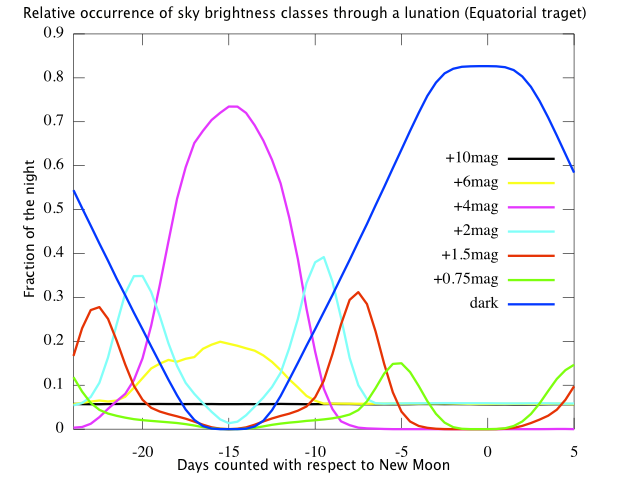
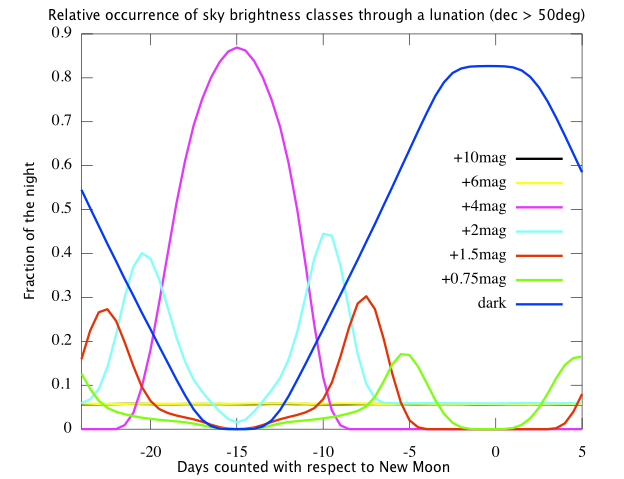
Plots illustrating how the availability of different conditions varies through
a lunation, here plotting the amount of time the telescope would be in each class, not
"in or darker than" the specified class. This plot is thus not directly relevent to
the scheduler, but does make it easier to visualize how the sky brightness varies
through the month.
A Worked Example
Take a hypothetical group that requests observations once every night but with no constraint on what time of night (i.e., a simple MONITOR with one-day period) and a sky brightness constraint of 2 mag.
The red and yellow bar chart "Cumulative Availability of Sky Brightness" says that averaged over a year, 65% of all time is "2mag or better". This plot however says nothing about individual nights. As far as this plot shows there might be some amount of 2mag time every night and the specified group might in fact be done every night. Obviously some nights it would have more chance than others.
The the next pair of plots "Availability of sky brightness through a lunation" does show something about individual nights. This shows the availability on each night through a month as the Moon moves. The cyan curve is for "2mag or darker". You see that at full Moon there is essentially no available time and really there is hardly any "2mag" available about 2 - 3 nights either side of full Moon.
Putting that together, about 65% of all time in the year is darker than 2mag, but there are 4 - 5 nights each month when there is very little and such a great is unlikely to be observable.
Remember also that these plots are averaged for some arbitrary "typical" target Ra,dec. A target in the ecliptic will certainly have a few nights each lunation when it is completely impossible whereas a target far out of the ecliptic might have a small amount of time when it is possible every night. You see this difference between the equatorial and high-latitude plots above. The equatorial one is much more strongly effected by the Moon in the 4mag (magenta) class.
Descriptive pictograms
The Phase2UI allows you to explicitly choose from a list of various sky brightnesses in magnitudes The following pictograms illustrate what brightness setting would arise from various familiar observing conditions.
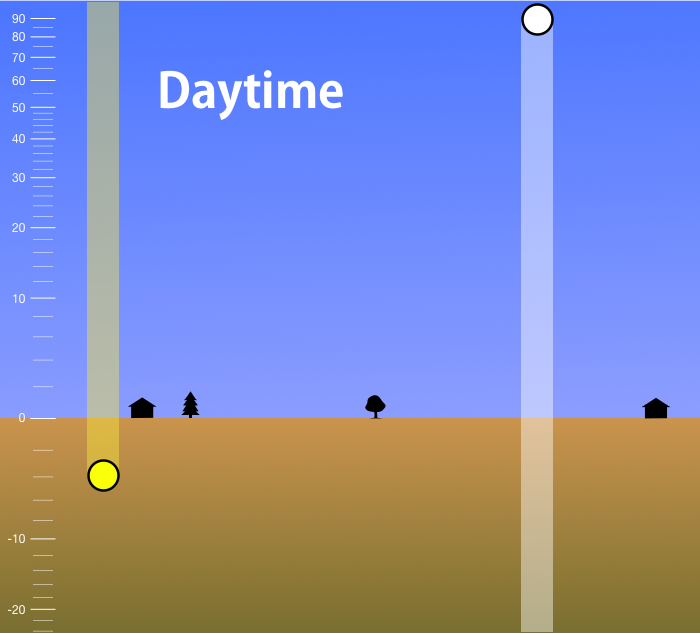
|
Sun and
Moon |
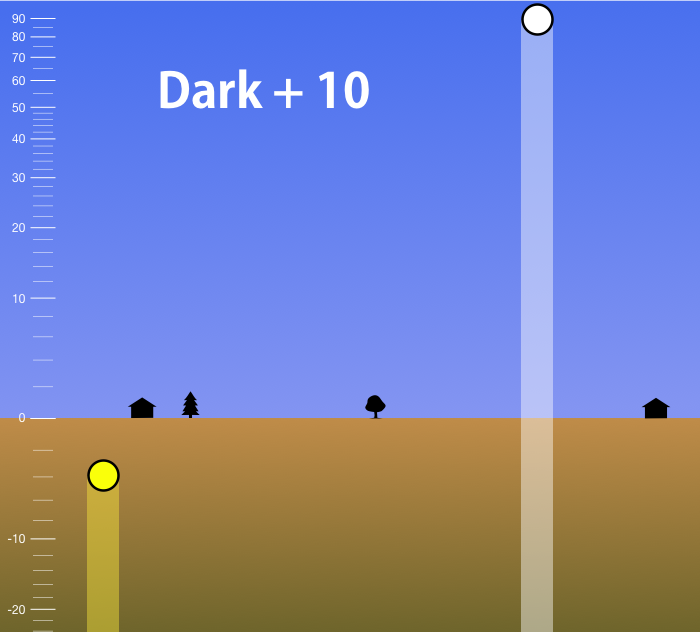
|
Sun and
Moon |
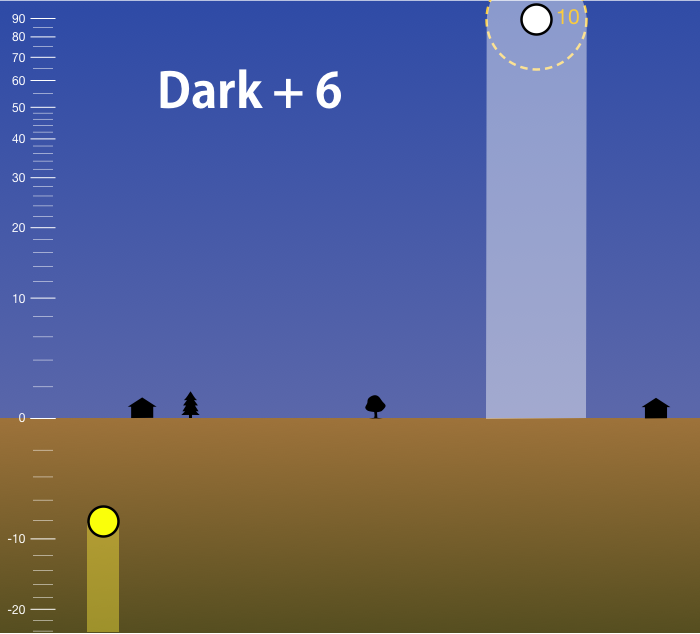
|
Effectively "Nautical Twilight"
Sun and
Moon |
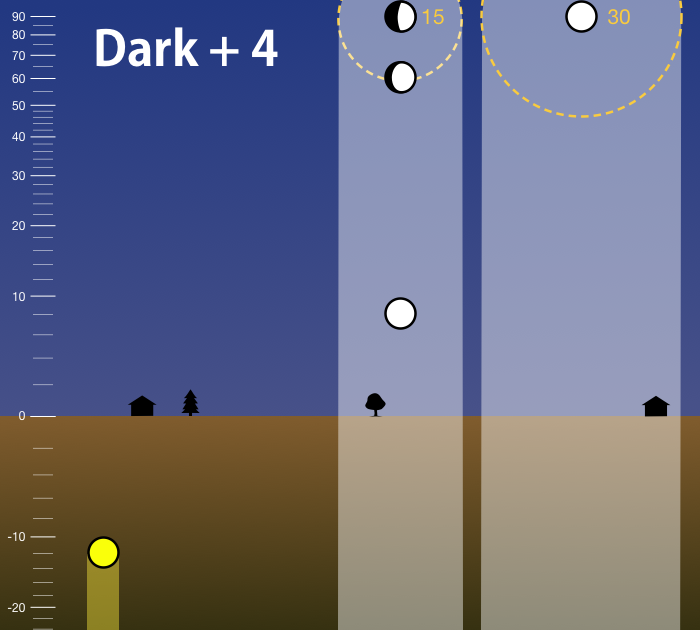
|
Effectively "Astronomical Twilight" or "full moon"
Sun and
Moon
Minimum distance 15°, at:
any altitude & up to 65% illuminated or up to 60° alt & 75% phase or up to 8° alt & full phase |
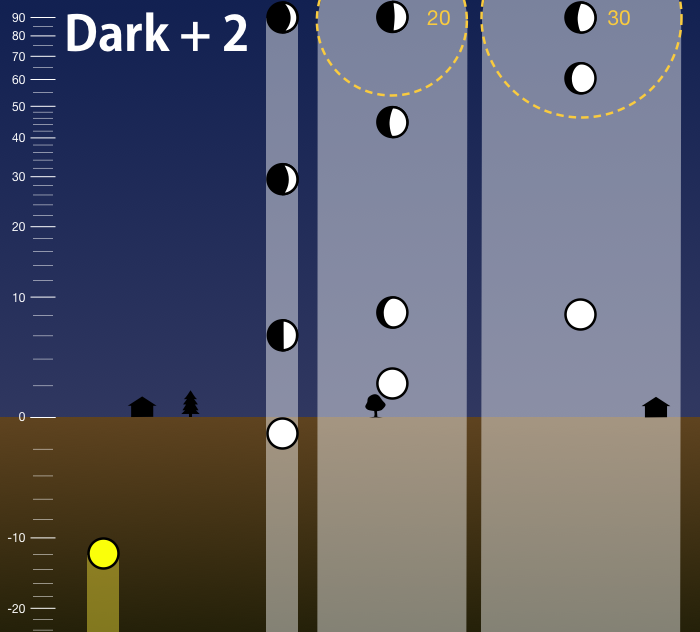
|
Effectively "Astronomical Twilight" or "high gibbous moon"
Sun and Moon
Minimum distance 30°, at:
or
any altitude & up to 65% illuminated, or up to 60° alt & 75% illuminated, or up to 8° alt & full phase
Minimum distance 15°, at:
or
any altitude & up to 45% illuminated, or up to 45° alt & half phase, or up to 8° & 75% phase
Minimum distance zero degrees, at:
any altitude & up to 25% illuminated, or up to 30° alt & 30% illuminated, or up to 5° alt & half phase, or 1° below horizon (or lower) & full phase. |
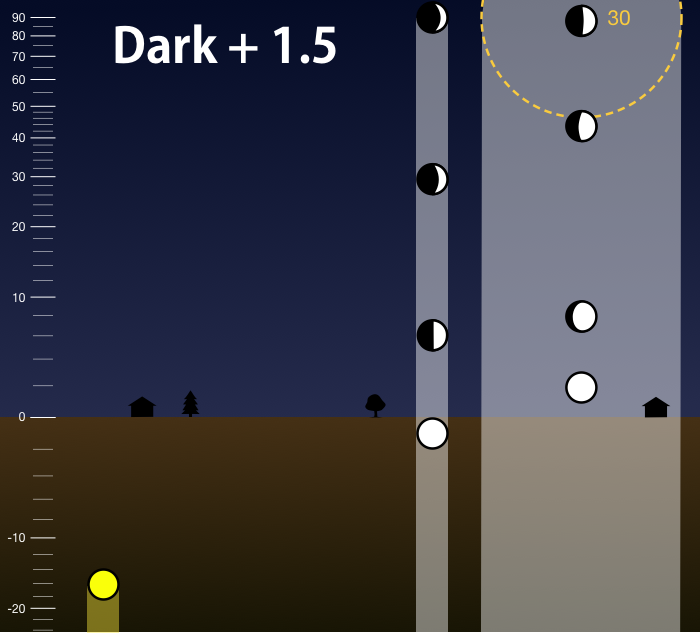
|
Effectively "Night & high half moon", or "low full moon"
Sun and Moon
Minimum distance 30°, at:
or
any altitude & up to 45% illuminated or up to 45° alt & half phase or up to 8° alt & 75% illuminated
Minimum distance zero degrees, at:
any altitude & up to 25% illuminated or up to 30° & third phase or up to 5° & half phase or 1° below horizon (or lower) & full phase. |
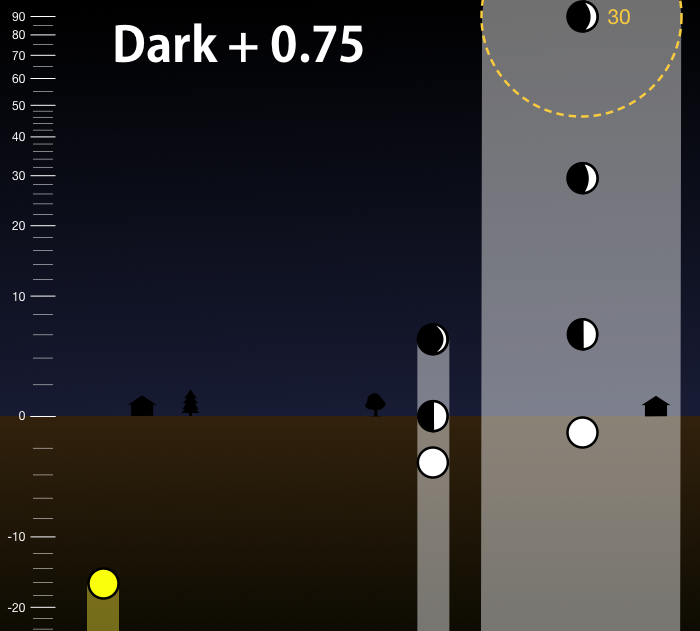
|
Effectively "Night & high crescent moon", or "low half moon"
Sun and
Moon
Minimum distance 30°, at:
or
any altitude & up to 25% illuminated, or up to 30° & third phase or up to 5° & half phase or up to 1° below horizon & full phase
Minimum distance zero degrees, at:
up to 5° altitude & 10% illuminated or on the horizon & half phase or 3° below horizon (or lower) and full phase |

|
Effectively "Night & at most low crescent"
Sun and
Moon
Minimum distance 30°, at:
up to 5° altitude & 10% illuminated, or on the horizon & half phase, or 3° below horizon (or lower) and full phase |


